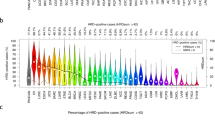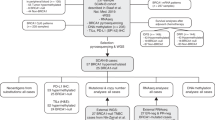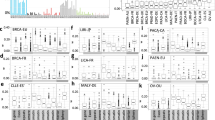Abstract
Biallelic inactivation of BRCA1 or BRCA2 is associated with a pattern of genome-wide mutations known as signature 3. By analyzing ∼1,000 breast cancer samples, we confirmed this association and established that germline nonsense and frameshift variants in PALB2, but not in ATM or CHEK2, can also give rise to the same signature. We were able to accurately classify missense BRCA1 or BRCA2 variants known to impair homologous recombination (HR) on the basis of this signature. Finally, we show that epigenetic silencing of RAD51C and BRCA1 by promoter methylation is strongly associated with signature 3 and, in our data set, was highly enriched in basal-like breast cancers in young individuals of African descent.
This is a preview of subscription content, access via your institution
Access options
Access Nature and 54 other Nature Portfolio journals
Get Nature+, our best-value online-access subscription
$29.99 / 30 days
cancel any time
Subscribe to this journal
Receive 12 print issues and online access
$209.00 per year
only $17.42 per issue
Buy this article
- Purchase on Springer Link
- Instant access to full article PDF
Prices may be subject to local taxes which are calculated during checkout







Similar content being viewed by others
References
Prakash, R., Zhang, Y., Feng, W. & Jasin, M. Homologous recombination and human health: the roles of BRCA1, BRCA2, and associated proteins. Cold Spring Harb. Perspect. Biol. 7, a016600 (2015).
Antoniou, A. et al. Average risks of breast and ovarian cancer associated with BRCA1 or BRCA2 mutations detected in case series unselected for family history: a combined analysis of 22 studies. Am. J. Hum. Genet. 72, 1117–1130 (2003).
Ceccaldi, R., Rondinelli, B. & D'Andrea, A.D. Repair pathway choices and consequences at the double-strand break. Trends Cell Biol. 26, 52–64 (2016).
Cancer Genome Atlas Network. Comprehensive molecular portraits of human breast tumours. Nature 490, 61–70 (2012).
Burstein, M.D. et al. Comprehensive genomic analysis identifies novel subtypes and targets of triple-negative breast cancer. Clin. Cancer Res. 21, 1688–1698 (2015).
Ellis, M.J. & Perou, C.M. The genomic landscape of breast cancer as a therapeutic roadmap. Cancer Discov. 3, 27–34 (2013).
Ciriello, G. et al. Comprehensive molecular portraits of invasive lobular breast cancer. Cell 163, 506–519 (2015).
Ceccaldi, R. et al. Homologous-recombination-deficient tumours are dependent on Polθ-mediated repair. Nature 518, 258–262 (2015).
Nik-Zainal, S. et al. Landscape of somatic mutations in 560 breast cancer whole-genome sequences. Nature 534, 47–54 (2016).
Alexandrov, L.B. et al. Signatures of mutational processes in human cancer. Nature 500, 415–421 (2013).
Lawrence, M.S. et al. Mutational heterogeneity in cancer and the search for new cancer-associated genes. Nature 499, 214–218 (2013).
Kim, J. et al. Somatic ERCC2 mutations are associated with a distinct genomic signature in urothelial tumors. Nat. Genet. 48, 600–606 (2016).
Kasar, S. et al. Whole-genome sequencing reveals activation-induced cytidine deaminase signatures during indolent chronic lymphocytic leukaemia evolution. Nat. Commun. 6, 8866 (2015).
Nielsen, F.C., van Overeem Hansen, T. & Sørensen, C.S. Hereditary breast and ovarian cancer: new genes in confined pathways. Nat. Rev. Cancer 16, 599–612 (2016).
Easton, D.F. et al. Gene-panel sequencing and the prediction of breast-cancer risk. N. Engl. J. Med. 372, 2243–2257 (2015).
Lord, C.J. & Ashworth, A. BRCAness revisited. Nat. Rev. Cancer 16, 110–120 (2016).
Eccles, D.M. et al. BRCA1 and BRCA2 genetic testing—pitfalls and recommendations for managing variants of uncertain clinical significance. Ann. Oncol. 26, 2057–2065 (2015).
Nik-Zainal, S. et al. Mutational processes molding the genomes of 21 breast cancers. Cell 149, 979–993 (2012).
Landrum, M.J. et al. ClinVar: public archive of relationships among sequence variation and human phenotype. Nucleic Acids Res. 42, D980–D985 (2014).
Meeks, H.D. et al. BRCA2 polymorphic stop codon K3326X and the risk of breast, prostate, and ovarian cancers. J. Natl. Cancer Inst. 108, djv315 (2015).
Scully, R. & Livingston, D.M. In search of the tumour-suppressor functions of BRCA1 and BRCA2. Nature 408, 429–432 (2000).
Merajver, S.D. et al. Germline BRCA1 mutations and loss of the wild-type allele in tumors from families with early onset breast and ovarian cancer. Clin. Cancer Res. 1, 539–544 (1995).
Cornelis, R.S. et al. High allele loss rates at 17q12-q21 in breast and ovarian tumors from BRCA1-linked families. Genes Chromosom. Cancer 13, 203–210 (1995).
Thompson, E.R. et al. Panel testing for familial breast cancer: calibrating the tension between research and clinical care. J. Clin. Oncol. 34, 1455–1459 (2016).
Southey, M.C. et al. PALB2, CHEK2 and ATM rare variants and cancer risk: data from COGS. J. Med. Genet. 53, 800–811 (2016).
Waddell, N. et al. Whole genomes redefine the mutational landscape of pancreatic cancer. Nature 518, 495–501 (2015).
Connor, A.A. et al. Association of distinct mutational signatures with correlates of increased immune activity in pancreatic ductal adenocarcinoma. JAMA Oncol. 3, 774–783 (2017).
Livingston, D.M. Cancer. Complicated supercomplexes. Science 324, 602–603 (2009).
Loveday, C. et al. Germline RAD51C mutations confer susceptibility to ovarian cancer. Nat. Genet. 44, 475–476 (2012).
Couch, F.J. et al. Inherited mutations in 17 breast cancer susceptibility genes among a large triple-negative breast cancer cohort unselected for family history of breast cancer. J. Clin. Oncol. 33, 304–311 (2015).
Blanco, A. et al. RAD51C germline mutations found in Spanish site-specific breast cancer and breast-ovarian cancer families. Breast Cancer Res. Treat. 147, 133–143 (2014).
Curtis, C. et al. The genomic and transcriptomic architecture of 2,000 breast tumours reveals novel subgroups. Nature 486, 346–352 (2012).
Pereira, B. et al. The somatic mutation profiles of 2,433 breast cancers refines their genomic and transcriptomic landscapes. Nat. Commun. 7, 11479 2016).
Foulkes, W.D. et al. Germline BRCA1 mutations and a basal epithelial phenotype in breast cancer. J. Natl. Cancer Inst. 95, 1482–1485 (2003).
Esteller, M. et al. Promoter hypermethylation and BRCA1 inactivation in sporadic breast and ovarian tumors. J. Natl. Cancer Inst. 92, 564–569 (2000).
Foulkes, W.D., Smith, I.E. & Reis-Filho, J.S. Triple-negative breast cancer. N. Engl. J. Med. 363, 1938–1948 (2010).
Dietze, E.C., Sistrunk, C., Miranda-Carboni, G., O'Regan, R. & Seewaldt, V.L. Triple-negative breast cancer in African-American women: disparities versus biology. Nat. Rev. Cancer 15, 248–254 (2015).
Rehm, H.L. et al. ClinGen—the Clinical Genome Resource. N. Engl. J. Med. 372, 2235–2242 (2015).
Spurdle, A.B. et al. ENIGMA—evidence-based network for the interpretation of germline mutant alleles: an international initiative to evaluate risk and clinical significance associated with sequence variation in BRCA1 and BRCA2 genes. Hum. Mutat. 33, 2–7 (2012).
Richards, S. et al. Standards and guidelines for the interpretation of sequence variants: a joint consensus recommendation of the American College of Medical Genetics and Genomics and the Association for Molecular Pathology. Genet. Med. 17, 405–424 (2015).
Hashizume, R. et al. The RING heterodimer BRCA1-BARD1 is a ubiquitin ligase inactivated by a breast cancer-derived mutation. J. Biol. Chem. 276, 14537–14540 (2001).
Górski, B. et al. Founder mutations in the BRCA1 gene in Polish families with breast-ovarian cancer. Am. J. Hum. Genet. 66, 1963–1968 (2000).
Abkevich, V. et al. Patterns of genomic loss of heterozygosity predict homologous recombination repair defects in epithelial ovarian cancer. Br. J. Cancer 107, 1776–1782 (2012).
Popova, T. et al. Ploidy and large-scale genomic instability consistently identify basal-like breast carcinomas with BRCA1/2 inactivation. Cancer Res. 72, 5454–5462 (2012).
Youden, W.J. Index for rating diagnostic tests. Cancer 3, 32–35 (1950).
Min, A. et al. RAD51C-deficient cancer cells are highly sensitive to the PARP inhibitor olaparib. Mol. Cancer Ther. 12, 865–877 (2013).
Evans, T. & Matulonis, U. PARP inhibitors in ovarian cancer: evidence, experience and clinical potential. Ther. Adv. Med. Oncol. 9, 253–267 (2017).
Chan, S.L. & Mok, T. PARP inhibition in BRCA-mutated breast and ovarian cancers. Lancet 376, 211–213 (2010).
Fong, P.C. et al. Inhibition of poly(ADP-ribose) polymerase in tumors from BRCA mutation carriers. N. Engl. J. Med. 361, 123–134 (2009).
Kaufman, B. et al. Olaparib monotherapy in patients with advanced cancer and a germline BRCA1/2 mutation. J. Clin. Oncol. 33, 244–250 (2015).
Patch, A.M. et al. Whole-genome characterization of chemoresistant ovarian cancer. Nature 521, 489–494 (2015).
Clamp, A. & Jayson, G. PARP inhibitors in BRCA mutation-associated ovarian cancer. Lancet Oncol. 16, 10–12 (2015).
Pathania, S. et al. BRCA1 haploinsufficiency for replication stress suppression in primary cells. Nat. Commun. 5, 5496 (2014).
Yeeles, J.T., Poli, J., Marians, K.J. & Pasero, P. Rescuing stalled or damaged replication forks. Cold Spring Harb. Perspect. Biol. 5, a012815 (2013).
Lindor, N.M. et al. A review of a multifactorial probability-based model for classification of BRCA1 and BRCA2 variants of uncertain significance (VUS). Hum. Mutat. 33, 8–21 (2012).
Hyman, D.M. et al. Precision medicine at Memorial Sloan Kettering Cancer Center: clinical next-generation sequencing enabling next-generation targeted therapy trials. Drug Discov. Today 20, 1422–1428 (2015).
Cibulskis, K. et al. Sensitive detection of somatic point mutations in impure and heterogeneous cancer samples. Nat. Biotechnol 31, 213–219 (2013).
Saunders, C. T. et al. Strelka: accurate somatic small-variant calling from sequenced tumor-normal sample pairs. Bioinformatics 28, 1811–1817 (2012).
Costello, M. et al. Discovery and characterization of artifactual mutations in deep coverage targeted capture sequencing data due to oxidative DNA damage during sample preparation. Nucleic Acids Res. 41, e67– (2013).
McKenna, A. et al. The Genome Analysis Toolkit: a MapReduce framework for analyzing next-generation DNA sequencing data. Genome Res. 20, 1297–1303 (2010).
Lek, M. et al. Analysis of protein-coding genetic variation in 60,706 humans. Nature 536, 285–291 (2016).
Carter, S.L. et al. Absolute quantification of somatic DNA alterations in human cancer. Nat. Biotechnol. 30, 413–421 (2012).
Acknowledgements
L.Z.B. was supported by the Louis B. Mayer Foundation. L.W.E. was supported by grants from the Avon Breast Cancer Crusade and the Breast Cancer Research Foundation (BCRF). G.G. and J.K. were partially funded by the NIH TCGA Genome Data Analysis Center (U24CA143845). P.P., N.J.H., Y.E.M., and A.K. were funded by the startup funds of G.G. at Massachusetts General Hospital. A.D.D. was supported by grants from the Ludwig Center at Harvard and the Breast Cancer Research Foundation (BCRF). W.D.F. was supported by Susan G. Komen. G.G. was partly funded by the Paul C. Zamecnick, MD, Chair in Oncology at Massachusetts General Hospital.
Author information
Authors and Affiliations
Contributions
P.P., J.K., and L.Z.B. conceived the work, performed analyses, and wrote the manuscript. R.K. and N.J.H. performed analyses and wrote the manuscript. G.T., D.R. and D.L. performed analyses. K.K. edited the manuscript. A.K., Y.E.M., and I.L. performed analyses and edited the manuscript. E.S.L. T.R.G., and A.Z. edited the manuscript. K.W.M. and A.O. wrote the manuscript. M.S.L. performed analysis and edited the manuscript. R.N.B. and C.C. provided data. D.A.H., L.W.E., and S.J.C. contributed scientific insight and edited the manuscript. P.W.L. and H.S. performed analysis and wrote the manuscript. A.D.D'A. conceived the work, contributed scientific insight, and edited the manuscript. W.D.F. and G.G. conceived the work, oversaw the analyses, and wrote the manuscript.
Corresponding author
Ethics declarations
Competing interests
T.R.G. is a cofounder of Foundation Medicine.
Supplementary information
Supplementary Text and Figures
Supplementary Figures 1–16 and Supplementary Note 1. (PDF 6139 kb)
Supplementary Table 1
ClinVar annotations of pathogenicity are reported, along with LOH status. (XLSX 47 kb)
Supplementary Table 2
Association between the functional characterization of BRCA1/2 missense variants with LOH and signature 3. (XLSX 41 kb)
Supplementary Table 3
Signature 3 and putative biallelic inactivation of BRCA1/2 correlate with clinical annotations among rare missense variants. (XLSX 41 kb)
Rights and permissions
About this article
Cite this article
Polak, P., Kim, J., Braunstein, L. et al. A mutational signature reveals alterations underlying deficient homologous recombination repair in breast cancer. Nat Genet 49, 1476–1486 (2017). https://doi.org/10.1038/ng.3934
Received:
Accepted:
Published:
Issue Date:
DOI: https://doi.org/10.1038/ng.3934
This article is cited by
-
Post-therapy emergence of an NBN reversion mutation in a patient with pancreatic acinar cell carcinoma
npj Precision Oncology (2024)
-
Human epidermal growth factor receptor-2 expression and subsequent dynamic changes in patients with ovarian cancer
Scientific Reports (2024)
-
BRCAness of brain lesions reflects a worse outcome for patients with metastatic breast cancer
Breast Cancer Research and Treatment (2024)
-
Prognostic relevance of HRDness gene expression signature in ovarian high-grade serous carcinoma; JGOG3025-TR2 study
British Journal of Cancer (2023)
-
Genomic analysis of advanced breast cancer tumors from talazoparib-treated gBRCA1/2mut carriers in the ABRAZO study
npj Breast Cancer (2023)



